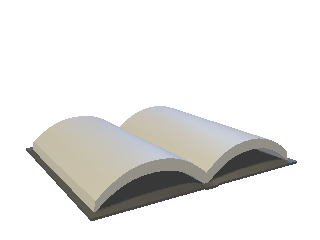
 Faculty Book Talk with Dr. T. David Gordon | March 26 | 4 - 5pm | Buhl Library Faculty Book Talk with Dr. T. David Gordon | March 26 | 4 - 5pm | Buhl Library |
In this issue:
Faculty Book Talk

Dr. T. David Gordon will discuss his book Promise, Law, Faith: Covenant-Historical Reasoning in Galatians on Thursday March 26th from 4 - 5pm in the library.
 |
Dr. Kim Miller.......................... Wednesday April 15th 4 - 5pm Buhl Library Join us for our last book talk of the spring semester! |
Daffin's Candy Bar Sale

Daffin’s Candy Bars are available at the Reference Desk for $1.00 each. Help us fundraise to provide classroom materials for Miss Cline’s K-5th Grade Autistic Support Classroom at Lakeview School District.

Mysteries of the Library Revealed
by: Kim Marks

When I was in graduate school, someone asked me what I was studying and when I told her I was studying to become a librarian, she responded, “Why do you need a master’s degree to sit around and stamp books all day?” At the time, I’ll be honest, this made me angry. But now, after nearly 14 years in this profession, I have a better understanding of why she asked that question because time and time again I am reminded that patrons don’t necessarily realize what a librarian does or how our education has prepared us for this profession.
In the past two newsletters, I’ve explained the work that librarians do to bring new books and journals into our library. This month, our series Mysteries of the Library Revealed is going to explain a little about what a librarian’s education includes and how it prepares him or her for the field. Read on for this third installment, “Where Do Librarians Come From? An Origin Story.”
Mystery #3: Where Do Librarians Come From? An Origin Story
Just like superheroes, librarians are not born; they are created. Fortunately, our origin stories do not involve bites from radioactive spiders or require us to carry lanterns with strange powers, but they are all unique. Some chose the profession because of a love of reading. Others enjoy the opportunity to work with students and support academics. Personally, I chose this profession because I love learning. Like a kid in a candy store, I can’t get enough and helping our patrons with their research means that I get to learn new things alongside them every day.
But before we can help others, budding librarians have a lot to learn. Continue reading to discover more about how our education prepared us for this field. We’ll start at the beginning: Library School.
Part 1: Library School – When you decide that you want to be a librarian, particularly an academic librarian like me, a master’s degree in library science, library and information science, or the like is a prerequisite. Upon completing our degrees, many librarians describe our education to others with the unofficial moniker “Library School,” which may make it seem less arduous than other graduate programs but the coursework required for these degrees provides a good mix of theoretical knowledge and practical skills to prepare us for work in a contemporary library.
While programs differ slightly from institution to institution, each one is designed to train up-and-coming librarians how information is organized and retrieved, how to choose and deselect items for a library’s collection, how to answer questions and assist users, and how to manage a library. From this core of essential skills, librarians can take courses that will personalize their work to a particular type of library or clientele (such as school or public libraries) and build their skills in fields such as cataloging, serials and databases, reference services, and user services. A final piece in many programs comes in the form of an internship so that newly trained library students have the opportunity to utilize their newfound skills and adapt them to one library’s needs.
Part 2: Learning the Ropes at Your Library – Once that diploma is in your hands and a job is secured, it’s easy to think that the learning is done for a while, but we’re just getting started. Even though newly minted librarians will be familiar with how a library works, every job means learning how this library works. How are the collections arranged? Where does the library keep the microforms? How will patrons access library resources off-campus?
It might seem easy to create a list or a training manual for new library employees. We do that for our student staff in fact; but for a librarian, it’s not that simple. Not only do we need to know the location of the print and online resources available at our library (which can vary significantly from other institutions) and how to use them, we also need to be familiar with assignments to answer professor/course-specific questions, basic copy machine and printer maintenance, locations of specific campus services and offices and much more to field the variety of questions we receive every semester. This sort of local knowledge takes times to learn and, because of the vast array of questions we receive, it is impossible to anticipate all of them when a new librarian joins the team.
Part 3: Keeping Up with the Times – Technology and information continue to change, which means that libraries must continue to adapt to serve the ever-changing needs of our users. To stay up to date on the latest advances and trends in areas such as academic publishing, cataloging, user experience, social media marketing, pedagogy, and circulation management, Buhl librarians attend conferences, view webinars, network with colleagues, follow listservs, and read library literature.
With all of the changes that have and will continue to occur with technology, information and education, I think it’s fair to say that a librarian’s learning is never done, which is great news for me!
I hope that you’ve enjoyed this installment of Mysteries of the Library Revealed. Please be sure to check out our newsletter next month when I’ll be talking about one of Buhl Library’s essential services to the campus community, Reference.
Featured Databases


Resources supporting patient information needs in multiple format types and covering topics such as aging, cancer, diabetes, drugs & alcohol, fitness, nutrition & dietetics, and more.
Coronavirus Resources

With the spread of the Coronavirus (COVID-19) on the rise worldwide and as we brace for its impact here in the states, we wanted to share reliable websites and resources that you can turn to for the latest information, news and updates. The two databases listed above - Health Source and Consumer Health Complete are great databases to use to search for the latest research. More resources include:
Comment Box
What's New?
Click on the book titles for book descriptions.
What's New?
Click on the book titles for descriptions and to access the eBook.
What's New?
Click on the book titles for descriptions and to access the eBook
Celebrate Ireland for St. Patrick's Day!
Find more books and resources about Ireland, Irish-American history, and fiction works that take place in Ireland or written by Irish authors on display this month in the library lobby.
Featured Database -
Consists of 170+ country guides documenting culture, customs, history, business, and more.
What is a Concordance?
by: Gretchen Maxeiner

Concordances are one of the more unusual types of research tool you might use in the library. They are most commonly associated with study the Bible but are also used in other fields involving careful review of literary texts. I used my first concordance as a graduate student of classical Latin; Grove City College students are often introduced to them early on in Bib Rev classes.
A concordance is a reference work listing most or all of the words in a book or collection of works. On a basic level, you can think of it like an alphabetical index of words, listing all the times a particular word is used in a text and pointing you to those exact locations. As an added value it also gives a bit of quotation in each instance so that you have some context for the use without continually flipping around in your Bible or text. Different concordances may have various bonus features which might make one more useful to you than another. For example, some will group different forms of a word (think “ride”, “rode” and “ridden”) together or else cross-reference between the root word and all the variants. Some will offer definitions and pronunciations. For the Bible there are even multilingual concordances that will connect the English word back to the Hebrew, Aramaic, and Greek word that is the basis of the translation.
Nowadays we are used to the “Find” feature in many online tools that allows us to search for all instances of a term in a text almost instantaneously. Some tools, like Microsoft Word, even give you a snippet of the surrounding text to provide context. But in the past pulling this information together was very laborious; the first Strong’s exhaustive concordance took almost 30 years to compile! Even today there is still a strong human element involved in producing a good concordance. Thus, only the most important works and authors—the sort scholars pore over in order to make very detailed textual assessments—have historically received concordances. The Bible was of course first, with the earliest concordances appearing in the 13th century. Key Greek and Latin works also received this treatment, and others thereafter. Today our library holds many Biblical concordances, typically based around particular English versions of the Bible, but also ones on Shakespeare, Chaucer, Milton, Spencer, Dante, Edgar Allan Poe, and the Qur’an. Perhaps you might have reason to use these unusual tools in your future studies.
Meet your Library Staff
Each month we will feature a Q&A with a Buhl permanent staff member or student from the library.
Meet Joyce Kebert

How long have you worked at Buhl Library?
Tell us a little about your educational background and work at GCC
Name 2 things that people might not know about you?
1. I am a big country music fan and love going to concerts. Last summer I made it to go see Garth Brooks.
2. I love to travel and visit national parks. To date, I have visited 20 different parks.
Book & Movie Recommendations
100 Years Ago...

(Britannica ImageQuest)
The Nineteenth amendment which granted women the right to vote in all elections in the United States was ratified 100 years ago in 1920. The exact date is August 18th, 1920. The first formal call for women's suffrage took place at the Seneca Falls Convention in 1848. Led by Elizabeth Cady Stanton and Lucretia Mott a "Declaration of Grievances" was created which listed the dissatisfactions women had with their current position in society. The lack of a right to vote was among those grievances however, not their main focus.
After women were excluded from the Fourteenth and Fifteenth Amendments ratified in the 1860s which focused on men and making it illegal to deny voting rights based on race and prior servitude, the first two women's voting rights organizations were created. The American Woman Suffrage Association founded by Lucy Stone and her husband, Harry Blackwell. At the same time Elizabeth Cady Stanton and Susan B. Anthony created the National Woman Suffrage Association. These two organizations merged creating the National American Woman Suffrage Association in 1880 after their first amendment was defeated by congress in 1887. Alice Paul and Carrie Chapman Catt were among the leadership of that organization. More than seventy years passed between the Seneca Falls Convention and the summer of 1919 when the house and senate passed the amendment. Now, approval was needed from thirty-six states to ratify the amendment. Tennessee was the thirty-sixth state to ratify the amendment on August 18th, 1920. Women were now guaranteed the right to vote in their first presidential election two months later in November of 1920. (Snider)
To celebrate this anniversary year, we will be featuring books on the 19th amendment and women's voting rights on display in the library lobby. To learn more, stop in and browse our collection! See a few featured titles below.
 From Parlor to Prison: five American suffragists talk about their lives by
From Parlor to Prison: five American suffragists talk about their lives by Source: Snider, Christy Jo. "Nineteenth Amendment." Salem Press Encyclopedia, 2019. https://search.ebscohost.com/login.aspx?direct=true&db=ers&AN=88960877&site=eds-live&scope=site
Contact Us

Email: refdesk@gcc.edu | Phone: 724-264-4729 | Website: hbl.gcc.edu